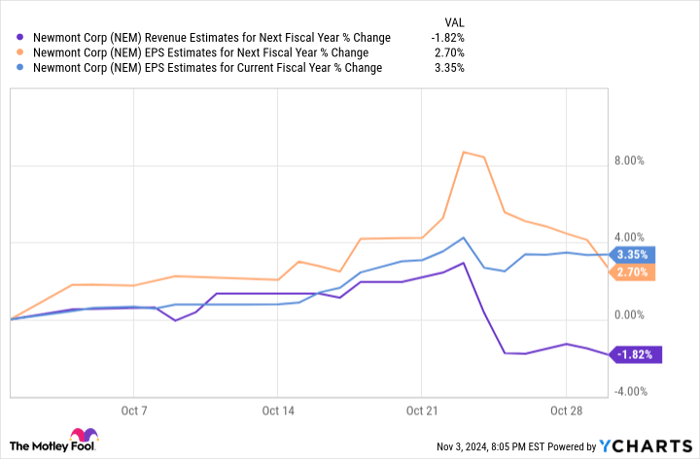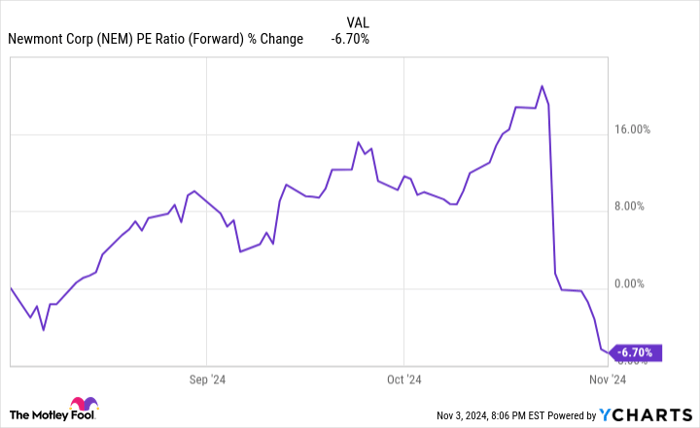Here's Why Newmont Corporation Stock Fell 15% in October

Shares of Newmont Corporation (NYSE: NEM) dropped 15% last month, according to data provided by S&P Global Market Intelligence. The mining stock released quarterly-earnings results in October that were mostly in line with analyst expectations. However, its commentary raised concerns about rising costs.
Newmont's headline figures aligned with expectations
Newmont Corporation's quarterly-earnings report looked positive at first glance.
Gold represents over 80% of the company's revenue, and surging precious metal prices fueled significant growth last quarter. The mining powerhouse achieved $4.6 billion of quarterly revenue, representing 85% growth over last year. Sales growth drove massive gains on the company's bottom line. Its operating earnings more than quadrupled, while free cash flow has tripled year to date (YTD). It was Newmont's most-profitable quarter in years.

IMAGE SOURCE: GETTY IMAGES.
The results were slightly higher than Wall Street's forecast on the top line, while earnings were marginally lower than expected. On the surface, the quarterly financials were overall positive and unremarkable compared to expectations. Unfortunately for shareholders, the market focused on concerning new developments on the expense side.
Rising costs represent a new challenge
Newmont reports "Costs Applicable to Sales" (CAS) for each of its mines and on a consolidated basis. Investors track these costs per ounce of gold produced by the company, providing an important data point when forecasting cash flows. Newmont's CAS per ounce was $1,207 last quarter, up more than 30% year to date and well above most analyst expectations. Mining companies are dealing with rising costs for several key categories, including labor and energy. Newmont is experiencing these issues in several different countries around the world, so it's not a simple fix or one underperforming location. It's keeping the company from fully exploiting the upside from higher gold prices.
Stocks often rise and fall along with forecasts for a company's future cash flows. Great quarterly results are sometimes overlooked when there are ominous signs for the future, and that's exactly what happened to the mining stock. Newmont's valuation already reflected the impact of rising gold prices -- the stock was up nearly 30% YTD at the start of October. Wall Street analysts slashed their revenue and earnings estimates for next year in response to the new CAS data.
NEM Revenue Estimates for Next Fiscal Year data by YCharts.
It's important for investors to keep the revision in context. The change was ultimately fairly modest, and the newest forecasts for next year's earnings are still higher than the consensus estimates from last quarter. Newmont's October slide can't be fully explained by lower-consensus estimates. The stock's forward price-to-earnings (P/E) ratio tumbled from nearly 19 to 14.3, indicating a relative lack of investor confidence.
NEM PE Ratio (Forward) data by YCharts.
Investors now perceive more risk, so they won't pay the same premium valuation that Newmont commanded before its earnings report. The newly discounted valuation is worth a look for anyone who wants to invest in gold.
Don’t miss this second chance at a potentially lucrative opportunity
Ever feel like you missed the boat in buying the most successful stocks? Then you’ll want to hear this.
On rare occasions, our expert team of analysts issues a “Double Down” stock recommendation for companies that they think are about to pop. If you’re worried you’ve already missed your chance to invest, now is the best time to buy before it’s too late. And the numbers speak for themselves:
- Amazon: if you invested $1,000 when we doubled down in 2010, you’d have $23,324!*
- Apple: if you invested $1,000 when we doubled down in 2008, you’d have $42,133!*
- Netflix: if you invested $1,000 when we doubled down in 2004, you’d have $420,761!*
Right now, we’re issuing “Double Down” alerts for three incredible companies, and there may not be another chance like this anytime soon.
*Stock Advisor returns as of November 4, 2024
Ryan Downie has no position in any of the stocks mentioned. The Motley Fool has no position in any of the stocks mentioned. The Motley Fool has a disclosure policy.









